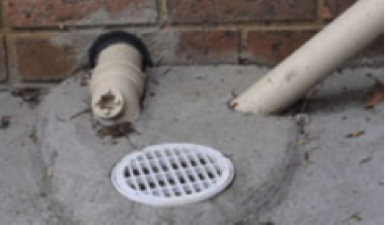Overflow Relief Gullies (ORGs)
An Overflow Relief Gully (ORG) protects the interior of your home or building from sewerage overflow. It is a drain like fitting located outside the property that is an important part of the plumbing system. In the event of a sewer blockage and ORG is designed release any sewerage overflow away from the interior of your building and outside to a garden or external area.
What is an Overflow Relief Gully?
An Overflow Relief Gully (ORG) is a drain-like fitting located outside the home, that allows sewage to overflow away from the interior of your home and outside to the garden if there is a sewer blockage.

How does it work?
If a sewer blockage occurs, the ORG fitting should pop off to release the pressure and direct sewage away from your home. It is the home owner’s responsibility to make sure their home is fitted with a properly designed and operational ORG. When an ORG is not functioning correctly the property damage and health risks associated with sewage spilling inside or under a property are greatly increased.
Claiming insurance following a sewer spill inside a property
As it is the home owner’s responsibility to make sure their home is fitted with a properly designed and operational ORG, an insurance claim for damages resulting from a sewer spill inside a building may be reduced when a non-compliant ORG is believed to have contributed to the magnitude of the damage.
Make sure your Overflow Relief Gully is not:
- underneath the property as a result of not being moved when a house extension was built (a plumber should move the existing ORG as part of constructing a house extension)
- blocked with concrete as a result of driveway or paving construction
- covered by landscaping or garden beds
- covered by any objects
- unable to pop off because it is corroded, filled with silt or concreted in
- a model which requires manual twisting in order to pop out.
Make sure your Overflow Relief Gully has:
- a clear drainage path (so spills drain away quickly without causing damage)
- a fitting that can pop off completely
- been installed at the correct level*
- *at least 150mm lower than the lowest fitting in the house (e.g. basin, shower, toilet, etc.) and usually 75mm above the surrounding ground.
What does it look like?
The shape and size can vary greatly. Generally they are between 100mm and 150mm in diameter and are either made of plastic or metal alloy. In some properties there are fittings that may look like an ORG that are called ‘disconnector gullies or gully traps’. These can easily be converted to an ORG, provided it is lower than any other waste outlets in the home.
Do all homes have an Overflow Relief Gully?
Most properties constructed after 1976 have an ORG, surrounded in concrete, near an external wall (or in special cases they may have a reflux valve). Buildings connected to the sewer prior to this date do not have an ORG unless additional work has been carried out since 1976. We strongly recommend that all homes have an ORG installed. When it is not possible to install a complying ORG, a reflux valve may be installed.
What is the difference between ORG models?
As ORGs have been installed since the late 1970s, many different models exist. We strongly recommend you install an approved model that is unhindered and pops off completely in an emergency.
Are ORG’s covered by regulations?
There are plumbing regulations that apply to the installation of ORG’s (National Plumbing Code AS 3500 1998). If you already have one installed, a licensed plumber should make an assessment as it may need to be repaired or replaced. If you don’t have one, contact a licensed plumber for a quote.
